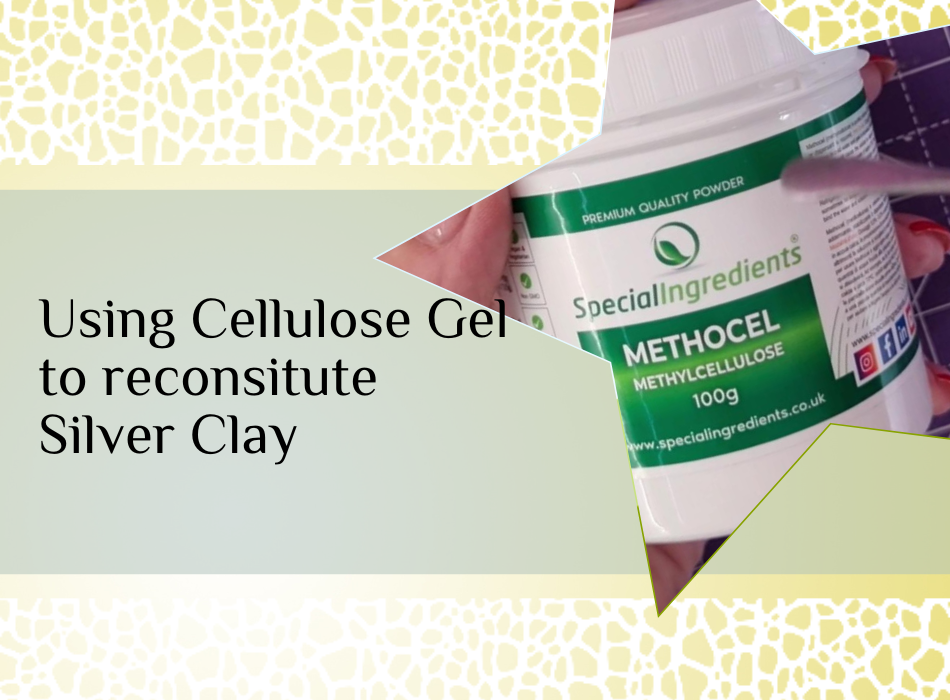Using Cellulose Gel to Reconsitute Silver Clay
Today, I am sharing my experiences of using cellulose gel to reconstitute silver clay. Why? Have you found that reconstituting your silver clay hasn’t been going as planned? Has it been crumbly and not coming together well? This can be disheartening, especially when you know that silver clay should be able to be reconstituted easily. This was a struggle one of my students faced. So I decided to do a little more investigation on her behalf.
When your clay is crumbly after it’s been reconstituted, often the advice is to mix with new clay to make it more supple. But that could be an issue if you don’t have the budget for more clay or you don’t have any to hand. That’s why I investigated using cellulose when reconstituting. Most of you will know that silver clay is made up of silver particles in an organic binder. What’s the organic binder? It’s sometimes cellulose. It can be other things as well, but cellulose is one of the ingredients frequently mentioned.
So, what is cellulose?
If you’re scientifically minded, then here’s the lowdown. Simply put, it’s a naturally occurring substance that is found in plants to keep them strong and stiff. It’s harmless to humans and in fact, can provide a source of fibre.
But, will it work well for reconstituting silver clay? The organic binder is there to provide flexibility and malleability. When your clay is reconstituting and it’s crumbly, then maybe the organic binder has been depleted. It’s worth trying to see whether it can be added back in.
I went and bought a small tube of cellulose from Amazon – for less than £8. It’s food grade so is used in cakes, biscuits etc to reduce the fat content and increase the fibre content. Although I wasn’t planning on eating it, it made me happy that it’s completely safe to handle.
I looked around to see if there were any people who had gone before me and experimented and of course there were. These Facebook groups dedicated to metal clay really are a gold mine of information!
If you’d prefer to see me reconstituting silver clay with cellulose, you can watch my video here.
Method to make cellulose gel
Having read through a few posts about it, I decided to make up a solution of 2.5g of cellulose powder to 50ml of warm water. It works better if the water is warm, the cellulose takes less time to dissolve. But even if your water is cold, it will dissolve, it’ll just take more time.
Once you’ve added the powder, stir thoroughly and then leave aside. I left mine for a couple hours then revisited it, squished out the white lumps with the back of my spoon, stirred again and left overnight. The gel should be completely transparent before using.
Prepare your silver clay for reconstituting
Once ready, prepare your clay. I like to grind my scraps in a mini food processor and then pass through a fine sieve. This takes any anomalies out of the clay and leaves a fine powder that can be easily mixed.
For this experiment – when I was weighing everything and taking notes, I had 100g of silver clay powder. I know this is quite a lot and probably more than most people do in one stage, but it gave me an easy number to measure. Previously I was mixing around 25g of powder, wasn’t sure how much cellulose gel to add, added too much and then had to add more powdered clay to get to a good consistency. So be aware! You actually need very small amounts of the cellulose gel to bind the powder together as you will see.
Using the Cellulose Gel to reconstitute Silver Clay – Method
Add a 2.5ml (half a teaspoon) of the gel to the powder and start to mix. At this stage, you’re aiming for the powder to start clumping together.
Once the clay does start to clump, add another 2.5ml (half a teaspoon) to the mix and then bring the mixture together.
At this point, I will pick up the clay and start to get it into a rough ball. It can be sticky at this stage and if it’s too sticky to pick up, you will need to add more silver clay powder.
Once the ball is loosely formed, I apply some release agent (usually Cool Slip, but olive oil will work just as well) to a plastic wallet folder. Place the ball of clay in the centre, close the wallet and then roll out your clay as thinly as you can.
Take some water, I use a spray bottle and apply it to the surface of the clay and massage in. Then pick the clay up and roll back into a ball. Do this at least twice, possibly more depending on how your clay feels. It should feel soft and malleable with no discernable cracking.
At this point, wrap in some plastic food wrap and pop into a airtight container. I usually have a baby wipe or damp paper towel in there too to provide a little moisture. Leave overnight. I usually leave a little longer – for 24 hours.
Things to consider:
You should have some lovely, reconstituted clay which you can use with confidence. I have been using it extensively and here’s what I’ve noticed:
- If you leave the clay for a while and it begins to dry out, it can start to get a little crumbly again. All I did to ‘rescue’ the clay was to roll it out flat, add a fingertip amount of the cellulose gel to the surface, along with a spritz of water. I rolled it back up and left it an hour or so and it was back to pliable and usable clay.
- It does shrink a little more than your new clay. My tests tell me that the Art Clay Silver 999 shrinks by 13%. My reconstituted ACS shrank by 16%.
- The cellulose gel can be stored in an airtight pot and used whenever you need. Handy to know since 50ml of the stuff is quite a lot when you’re only using 5ml at a time.
- The working time of the reconstituted clay has been increased – including when I made a rather long and thin coil as a border to a pendant.
- I had read that adding cellulose gel to clay can make it more flexible. I’ve got to say that I did not find this to be the case.
Conclusion
To conclude, this has changed the way I reconstitute clay. I often reconstitute the clay I use multiple times. This is because I am constantly practicing, experimenting and demonstrating. Adding cellulose gel to enhance the depleted binder in reconstituted clay makes the clay better and to my mind, it is worth that extra step.
Please let me know if this is something new to you. Will you be trying it out?







Thank you Emma, I really appreciate all the work you’ve put in for me and everyone else struggling with bitty clay. I’ll be trying this method of reconstitution asap.
Hi Emma
I will be trying this method. I’ll let you know what I think. I have tried adding glycerin and lavender oil in the past however I am hoping this will give me more flexible clay…,still missing PMC flex :(.
Hey Lynne
I didn’t notice any change in the flexibility of the clay – sorry
Emma x
Thank you for the info.
You are a life saver! Thank you for sharing
You’re so welcome!
Thanks Emma, I’ve ordered some and will be giving it a go x
Excellent! Good luck and remember this product goes a LONG way so add less of it if you’re unsure.